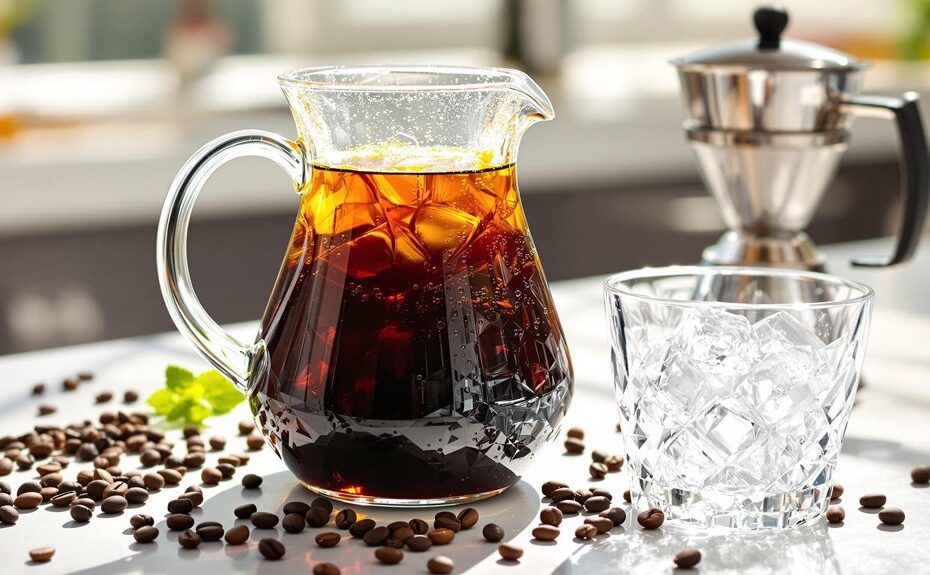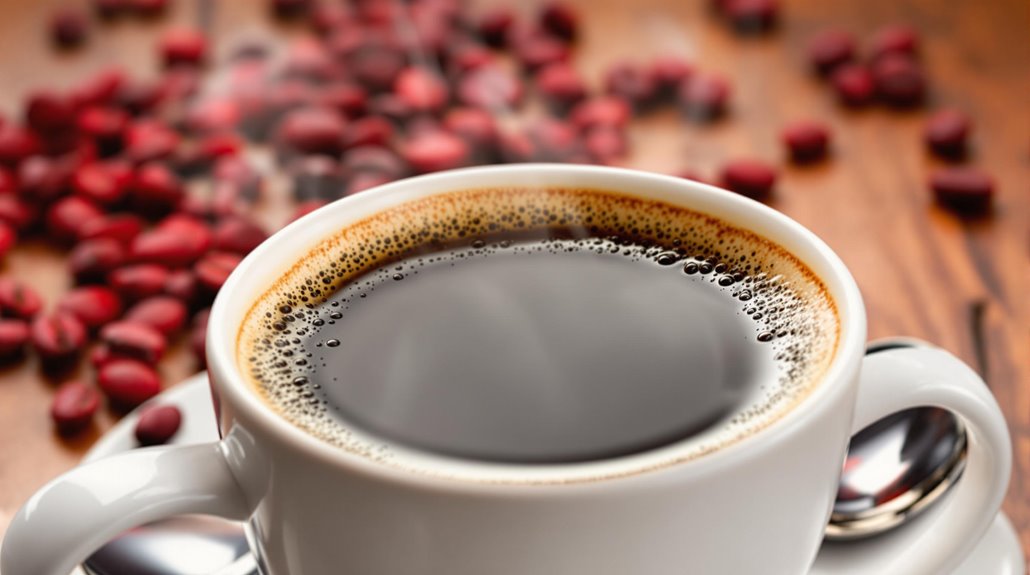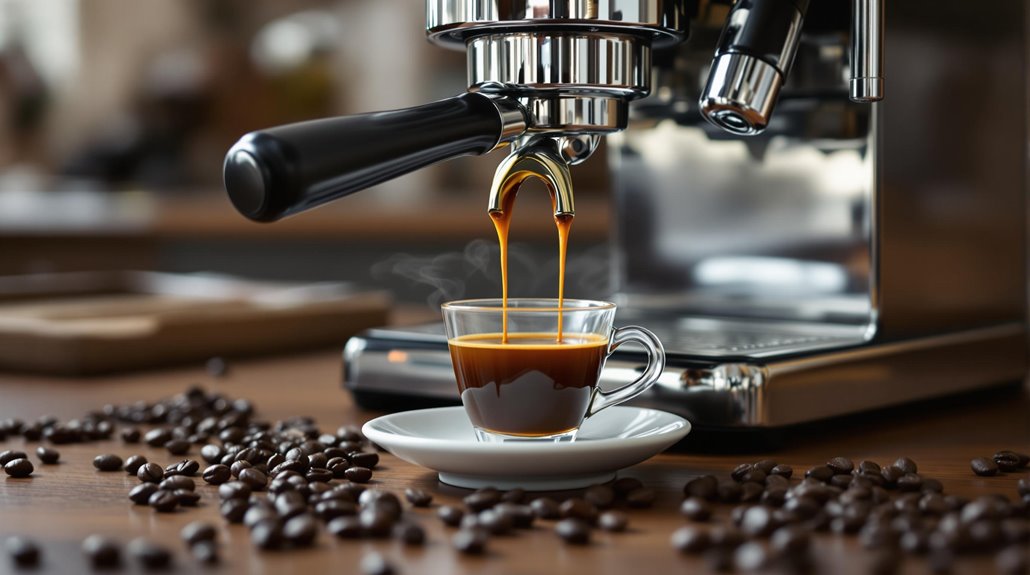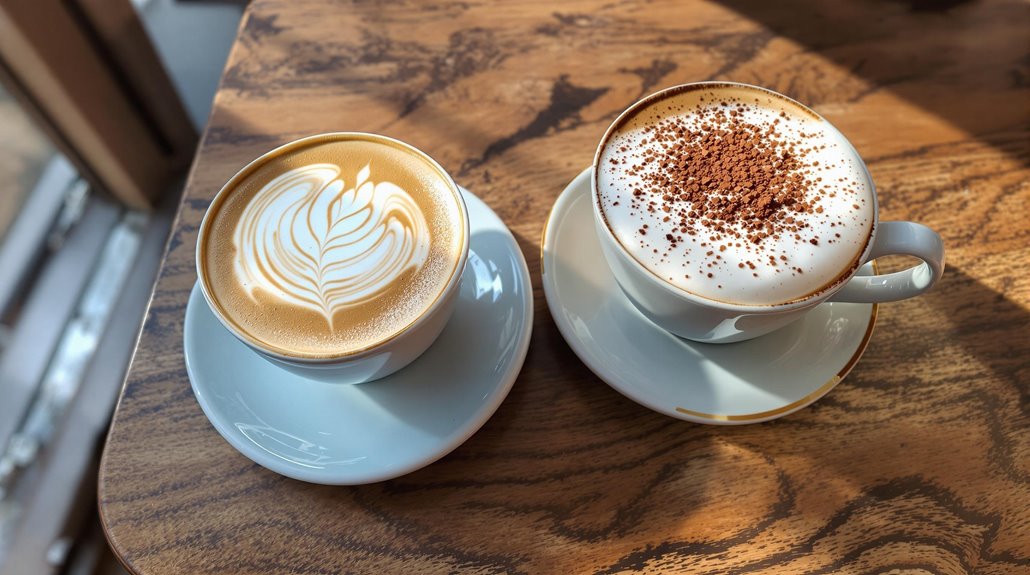







When it comes to making iced coffee, you've got several methods to evaluate, each with its own merits. You might find the pour-over technique particularly intriguing, as it allows for a vibrant flavor profile and careful control over dilution. By starting with the right measurements and technique, you can truly enhance your iced coffee experience. But what about alternatives like cold brew or shaken espresso? Each method brings something unique to the table, and the choice can greatly impact your daily caffeine ritual. Let's explore these options further to uncover the best fit for you.
Key Takeaways
- Use the cold brew method for a smooth, less bitter flavor by steeping coarsely ground coffee in room temperature water for 12-24 hours.
- The pour-over technique allows for vibrant flavors with controlled dilution; aim for a 1:15 coffee-to-water ratio.
- Always bloom coffee grounds with hot water before brewing to enhance aroma and flavor extraction.
- Serve iced coffee immediately after brewing to maintain optimal taste and prevent bitterness.
- Experiment with sweeteners like sweetened condensed milk or flavored syrups for a personalized iced coffee experience.
Overview of Iced Coffee Methods
When you're exploring iced coffee methods, it's essential to understand the differences in brewing techniques that can elevate your experience. Iced coffee is typically brewed hot and then chilled, giving you that familiar taste with a revitalizing twist. On the other hand, cold brew involves steeping coffee grounds in room temperature water for 12 to 24 hours, resulting in a smooth, less bitter flavor profile.
If you're looking for something dynamic, consider the Japanese method. This technique combines hot brewed coffee directly onto ice, producing a vibrant iced coffee that benefits from the controlled dilution of melting ice. For cold brew, remember that a higher coffee-to-water ratio—around 1 lb. of coffee to 8 qt. of water—is key to creating a strong concentrate you can adjust to your liking.
While methods like the Moka pot offer robust flavors and can be highly rated for iced coffee, drip coffee often falls short with bitterness. Quick options like pouring hot coffee over ice or using an Aeropress can work, but for richer flavors and smoother textures, cold brew and the Japanese method should be your go-to choices in coffee brewing.
The Pour-Over Technique

The pour-over technique transforms iced coffee into a refined experience by brewing hot coffee directly onto ice, creating a vibrant flavor profile. You'll appreciate how this method controls dilution and enhances complexity, all while maintaining a clean taste that's free from bitterness. To achieve perfection, focus on your coffee-to-water ratio and embrace the beauty of freshly ground beans for every brew.
Brewing Method Overview
If you're looking to elevate your iced coffee game, mastering the pour-over technique is a game changer. This brewing method allows you to brew hot coffee directly onto ice, giving you immediate chilling while controlling dilution as the ice melts. To achieve the perfect cup, start with a coffee-to-water ratio of about 1:15. For 12 ounces of iced coffee, use roughly 25 grams of medium-finely ground coffee.
Begin your brewing process by saturating the coffee grounds with around 65 grams of hot water. This blooming step is essential; it enhances the coffee's aroma and flavor, setting the foundation for a delightful iced coffee experience. The total brewing time is just 2 to 3 minutes, making it a quick yet effective method.
As the hot coffee cascades over the ice, it captures the complexity of your high-quality coffee beans, resulting in bright and nuanced flavors without the bitterness often found in other methods. The pour-over technique not only showcases your coffee's unique characteristics but also transforms your iced coffee into a revitalizing masterpiece. Embrace this method, and you'll never look back!
Flavor Profile Benefits
Through the pour-over technique, you reveal a world of flavor possibilities that elevate your iced coffee experience. This method brews hot coffee directly onto ice, instantly chilling the brew while allowing for controlled dilution. You'll find that the pour-over method preserves vibrant aromas and bright flavors, setting it apart from other brewing techniques.
When you use a medium-finely ground coffee at a ratio of 25 grams for 12 ounces of iced coffee, you maximize the extraction of nuanced flavors during the blooming process, yielding a clean, smooth profile that highlights coffee's inherent qualities. This attention to detail means you can savor every sip without the bitterness often found in other methods.
Moreover, the pour-over technique offers a level of customization that lets you adjust grind size and water temperature to cater to your personal taste. Whether you prefer a bolder flavor or a more delicate brew, you have the power to create your ideal iced coffee. In just about five minutes, you'll craft an iced coffee that not only refreshes but also delights your palate with its exquisite flavor profile.
Tips for Perfection
For achieving iced coffee perfection using the pour-over technique, precision and attention to detail are vital. Start with 25 grams of medium-finely ground coffee for every 12 ounces of water. This balance guarantees you highlight the coffee flavor's nuances. Begin the brewing process by blooming the coffee with 65 grams of hot water. This step allows the grounds to release carbon dioxide, enhancing the extraction. It's essential to use a scale for accurate measurements; inconsistent grind sizes can lead to changes in flavor profiles, impacting your final iced coffee.
To create the best iced coffee, brew directly onto ice in a glass. This method chills the coffee instantly and controls dilution, resulting in a smoother beverage. Aim for a total brewing time of about 2 minutes and 30 seconds. This timeframe guarantees full extraction while keeping the coffee vibrant and aromatic, steering clear of any bitter notes. With these tips, you're on your way to mastering pour-over coffee, creating a revitalizing treat that showcases the rich flavors of your chosen beans. Enjoy the process, and savor every sip!
Japanese Flash-Brewing Explained
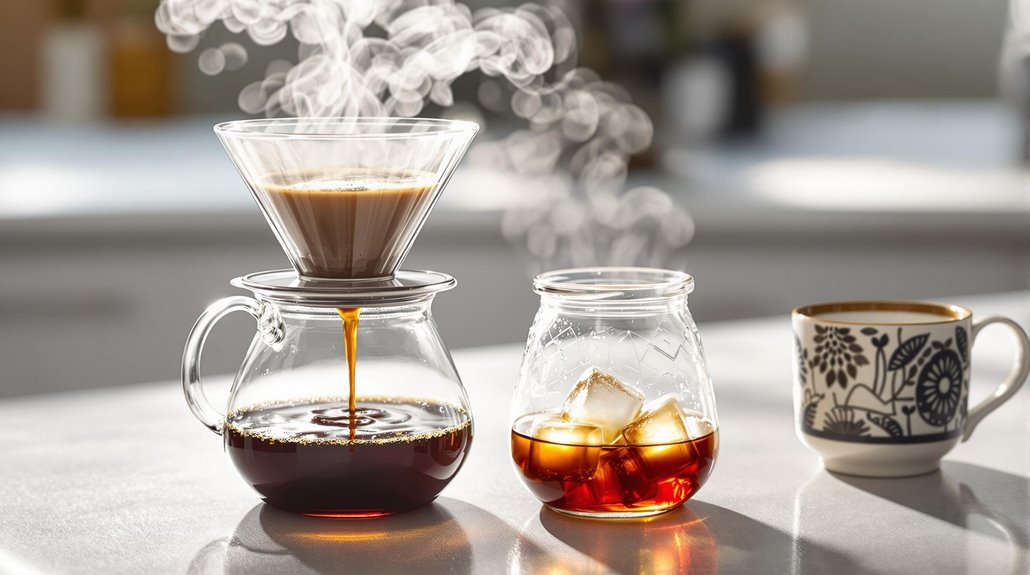
When it comes to crafting the perfect iced coffee, the Japanese flash-brewing method stands out as an art form that balances precision and flavor. This technique combines hot water brewing with ice in the serving vessel, creating a dynamic, flavorful iced coffee experience that you won't forget. For best results, you'll want to use 25 grams of medium-finely ground coffee for every 12 ounces of iced coffee, replacing 250 grams of hot water with 150 grams of ice.
Start by saturating the coffee grounds with 65 grams of water, then gradually add more water over a total brewing time of approximately 2 minutes and 30 seconds. This meticulous approach allows for controlled dilution; as the ice melts, it enhances the coffee's flavor without sacrificing richness. The Japanese flash-brewing method delivers a balanced coffee experience, making it ideal for those who appreciate a robust flavor profile in their iced coffee.
Cold Brew vs. Traditional Brewing
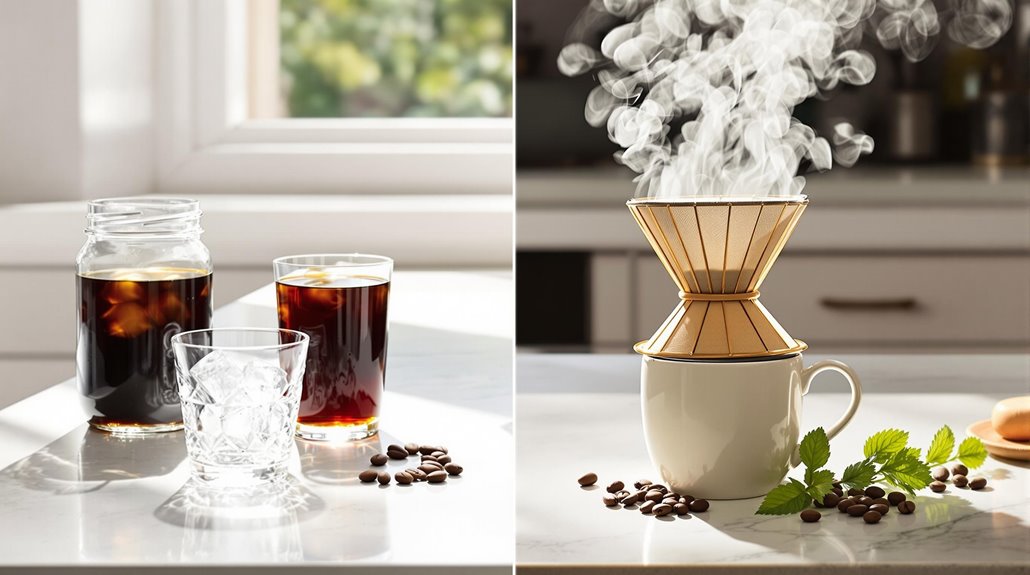
When you compare cold brew and traditional iced coffee, you're really exploring two distinct flavor worlds and brewing approaches. Cold brew offers a smooth, low-acidity taste that many find appealing, but it takes patience with its long steeping time. On the other hand, traditional brewing delivers a bolder flavor quickly, though it can come with some bitterness if not managed well, making cost and efficiency key factors in your decision.
Flavor Complexity Comparison
Many coffee enthusiasts find themselves debating the merits of cold brew versus traditional brewing methods, particularly when it comes to flavor complexity. Cold brew is known for its smooth profile, but it often lacks the vibrant flavor and intricate nuances that traditional brewing can deliver. This is mainly because cold brew misses out on the volatile aromatic compounds released during the roasting process, which are essential for a dynamic taste experience.
When you opt for traditional methods like pour-over or Japanese flash-brewing, you harness the power of hot water to extract essential oils and aromatic compounds. This allows for a richer flavor profile and highlights the coffee's unique notes and acidity. Curiously, cold brew typically requires double the amount of coffee grounds to achieve a robust flavor, which can increase your cost per cup compared to traditional methods that use less coffee for more complex flavors.
Flash-brewing combines the best of both worlds, using hot water for extraction while immediately chilling the brew. This technique preserves those aromatic qualities, enhancing overall flavor complexity. If you're seeking an exciting coffee experience, traditional brewing methods may just be your best bet.
Brewing Time Differences
Though you're enthusiastic for a rejuvenating cup of iced coffee, the brewing time can considerably influence your experience and flavor. Cold brew requires a steeping time of 12 to 24 hours, allowing the coffee grounds to extract slowly, resulting in a less acidic, smoother flavor profile. This method uses a coffee-to-water ratio of 1 lb of coffee for 8 qt of water, making it perfect for batch brewing. You can easily prepare a large batch and store it in the refrigerator for several days, ensuring you have a revitalizing drink ready when you need it.
In contrast, traditional brewing methods, like drip or pour-over, take only about 5 to 10 minutes. While quick, this approach can yield more pronounced acidity and bitterness due to heat extraction. Typically, traditional brewing uses around 2 tablespoons of coffee per 6 ounces of water. Although it's faster, you'll want to enjoy your iced coffee shortly after brewing to keep its flavor integrity intact.
Ultimately, your choice between cold brew and traditional brewing hinges on how much time you're willing to invest for your ideal iced coffee experience.
Cost Efficiency Analysis
Choosing between cold brew and traditional brewing not only affects flavor but also impacts your wallet. Cold brew requires a hefty amount of coffee grounds, often using a coffee-to-water ratio of 1 lb. of coffee to 8 qt. of water. This means you might end up spending more for each cup compared to traditional iced coffee, which uses less coffee and brews quickly.
While cold brew offers a smooth flavor, its preparation time can stretch from 12 to 24 hours, making it less appealing if you're craving a quick caffeine fix. On the other hand, traditional iced coffee can be whipped up in mere minutes, letting you enjoy that invigorating drink without the wait.
However, the cost efficiency of cold brew may be balanced by its convenience. Once prepared, you can store it for multiple servings, perfect for those who drink iced coffee regularly. If you value the ability to brew in bulk and have coffee ready to go, cold brew might be worth the initial investment. Ultimately, the choice depends on your preference for flavor, time, and budget.
Shaken Espresso for Iced Coffee

Shaken espresso transforms your iced coffee experience into a delightful ritual that captures the essence of bold flavor and invigorating texture. This method involves pulling freshly brewed espresso shots and shaking them vigorously with ice, creating a frothy texture that enhances the coffee's flavor profile. It's perfect for crafting iced Americanos or Italian shakeratos, offering a rejuvenating twist on your usual iced coffee.
To make shaken espresso, simply brew your espresso and fill a shaker with ice. Shake it for about 15-30 seconds until you achieve that beautiful froth. You can customize your drink with sweeteners or milk to match your taste preferences, making each cup uniquely yours. For an added touch, consider garnishing with a twist of orange peel or a sprig of mint—these accents elevate both the presentation and the flavor.
If you're a moka pot enthusiast, don't worry; this technique can adapt beautifully to your brewing style, allowing you to enjoy the same frothy result. Embrace the ritual of shaken espresso, and elevate your iced coffee experience to new heights!
Essential Ingredients and Measurements
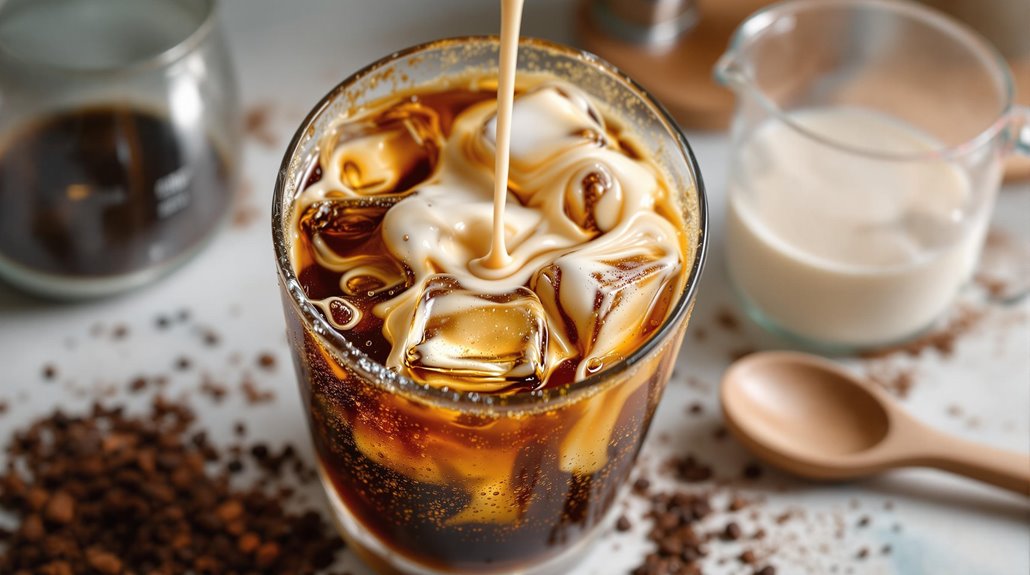
To elevate your iced coffee experience, starting with the right ingredients and measurements is key. For a basic iced coffee, use a rich roast ground coffee at a coffee-to-water ratio of 1 pound to 8 quarts of cold water. This guarantees prime flavor extraction. If you're aiming for a smoother, less acidic taste, prepare a cold brew by steeping coarsely ground coffee in cold water for 12 to 24 hours.
For a more intense flavor, consider brewing a concentrated version by using half the usual amount of water. Once brewed, pour this coffee concentrate over ice for a revitalizing kick. For added richness, mix in 2 to 3 tablespoons of sweetened condensed milk per serving, or opt for half-and-half to enhance the overall flavors and aromas.
When measuring your coffee, remember that 17 grams is approximately 2 ½ tablespoons, ensuring you maintain the precise coffee-to-water ratio for the best results. Master these essential ingredients and measurements, and you'll be well on your way to crafting an exceptional iced coffee that will delight your senses.
Serving Tips and Variations
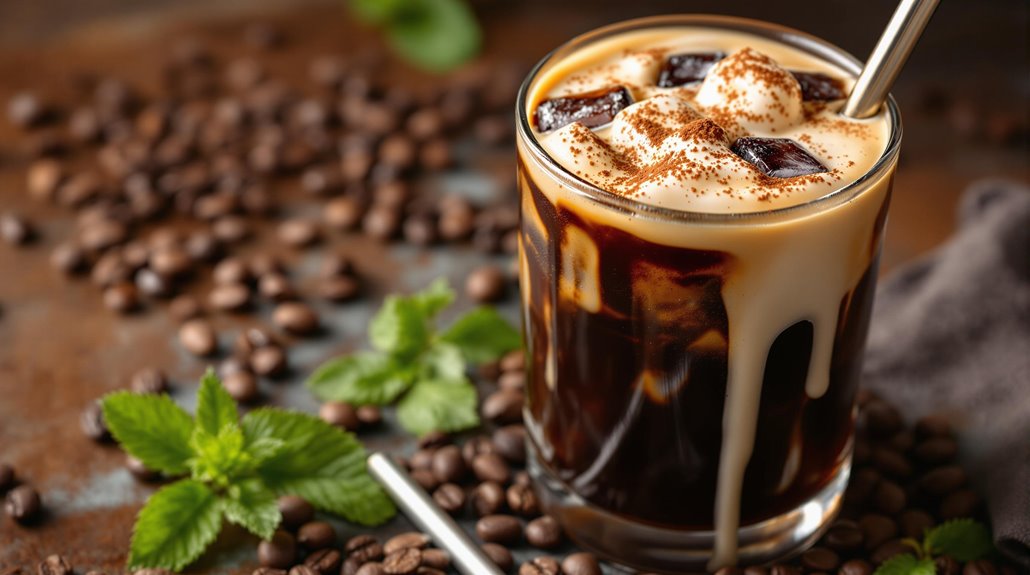
There's no denying that serving iced coffee with flair can elevate your overall experience. To make the perfect glass of iced coffee, start by filling your glass with ice cubes before pouring the coffee concentrate. This technique chills your brew without diluting it right away. For a creamier texture, don't hesitate to add a splash of half-and-half or sweetened condensed milk—aim for at least 2 tablespoons to really enhance the flavor.
But why stop there? Experiment with flavor variations to make your iced coffee truly yours. Fresh herbs like mint or a sprinkle of cinnamon can add an unexpected twist that'll impress your taste buds. If you're concerned about dilution, consider using coffee ice cubes made from brewed coffee. These will maintain the rich flavor as they melt.
Finally, customize your iced coffee by adjusting the sweetness with syrups or flavored creams. Whether you prefer it sweetened or with just a hint of cream and sugar, the choice is yours. Each sip of your personalized creation will be a rejuvenating delight, redefining your iced coffee experience!
Disclosure: As an Amazon Associate, I earn from qualifying purchases.
